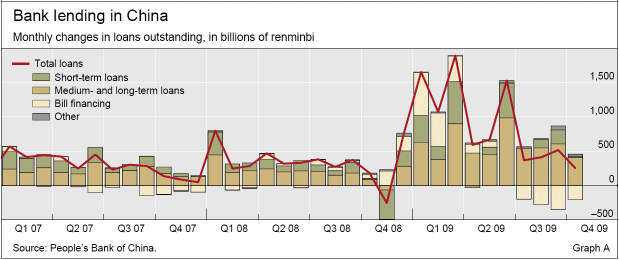Analysing bank lending data in China
(Extract from pages 20-21 of BIS Quarterly Review, December 2009)
Credit growth has either slowed markedly or turned negative in most economies since the inception of the international crisis. A noticeable exception is China, where credit growth has accelerated remarkably since late 2008. Here we investigate the dynamics of Chinese banks' lending activity and its implications for the real economy.
Under the Chinese government's stimulus plan, credit expanded at an extraordinary rate in the first half of 2009. Chinese banks extended CNY 7.4 trillion worth of new loans, far more than the full-year total of CNY 4.2 trillion in 2008. The credit expansion contributed to the strong recovery of China's economy, but also raised concerns about excessively loose credit conditions. A significant portion of bank loans might have flowed into the equity and real estate markets, leading to asset price booms. In the first seven months of the year, the Shanghai Stock Exchange index rose by 87%, with the price/earnings ratio almost doubling from 15 to 29. Housing markets also regained momentum, registering increases in sales and investments as well as prices.
Against this backdrop, the Chinese government took prudential measures to curb lending to sectors with overcapacity as well as to improve the soundness of the banking system. The bank regulator issued a series of guidelines on lending practices to make sure that loans were not used for other purposes. Moreover, in order to strengthen the banking system's loss absorption capacity, the regulator also raised loan loss provisioning requirements for banks and tightened rules on the calculation of bank capital. In response, net lending eased notably in the third quarter, to CNY 1.3 trillion, and declined further in October to a year-low of CNY 253 billion.
The levelling-off of the lending expansion has so far had little adverse impact on the real economy. Indeed, GDP growth rose to 8.9% in the third quarter, and is expected to remain strong in the coming quarters. There are several possible reasons for this apparent disconnect.
First, the full impact of monetary stimulus on the real economy generally takes some time to be felt. In the case of China, strong economic growth in the third quarter may be the consequence of the rapid loan growth during the first half of the year.
Second, the slowdown in net bank lending since July may in part reflect seasonality in banks' lending practices. Loan growth in China is typically stronger in the first half of a year as banks tend to front-load their lending. We estimate that seasonal effects accounted for 14 percentage points of the 68% drop in monthly net lending from the first to the second half of the year. In fact, net lending between July and October was 28% higher compared with the same period one year ago.
Finally, and most importantly, the composition of credit has changed notably in recent months (Graph A). The drop in net bank lending was mainly driven by the sharp decline in the volume of discounted corporate bills and lower short-term lending. By contrast, the volume of medium- and long-term loans, which arguably provide more direct support for investment and real economic activity, continued to expand at a brisk pace.
Bill financing totalled CNY 1.7 trillion in the first half of the year, the highest level on record. This probably reflected a strategy on the part of banks to increase total lending in response to the stimulus plan, while at the same time maintaining flexibility in their asset portfolios. Borrowers had traditionally used bills as a source of low-cost funding to meet their working capital needs. Arguably, a significant portion of those funds may have flowed into the asset markets. As from July, banks have started to reduce the supply of discounted bills, answering the regulator's call for more moderate credit growth. Meanwhile, the persistently strong issuance of medium- to long-term loans means that support for economic growth would be maintained. Given that outstanding bill financing amounted to CNY 2.6 billion at the end of October, there is still room for banks to adjust loan composition in the same direction.
While strong loan growth in China has fuelled the current economic recovery, it is not without risks. For one, the rapid credit growth in the first half of the year was unavoidably associated with an easing in credit standards, which could reduce the quality of banks' balance sheets in the future. In addition, the big increase in investment driven by credit expansion may imply additional demand for loans in the future, to complete the underlying projects. A tightening of monetary policy, therefore, may leave projects incomplete and lead to a build-up of bad loans in the banking sector. Together with the intensified pressure from the influx of international capital flows, Chinese policymakers may face significant constraints on their monetary and credit policy in the years ahead.

